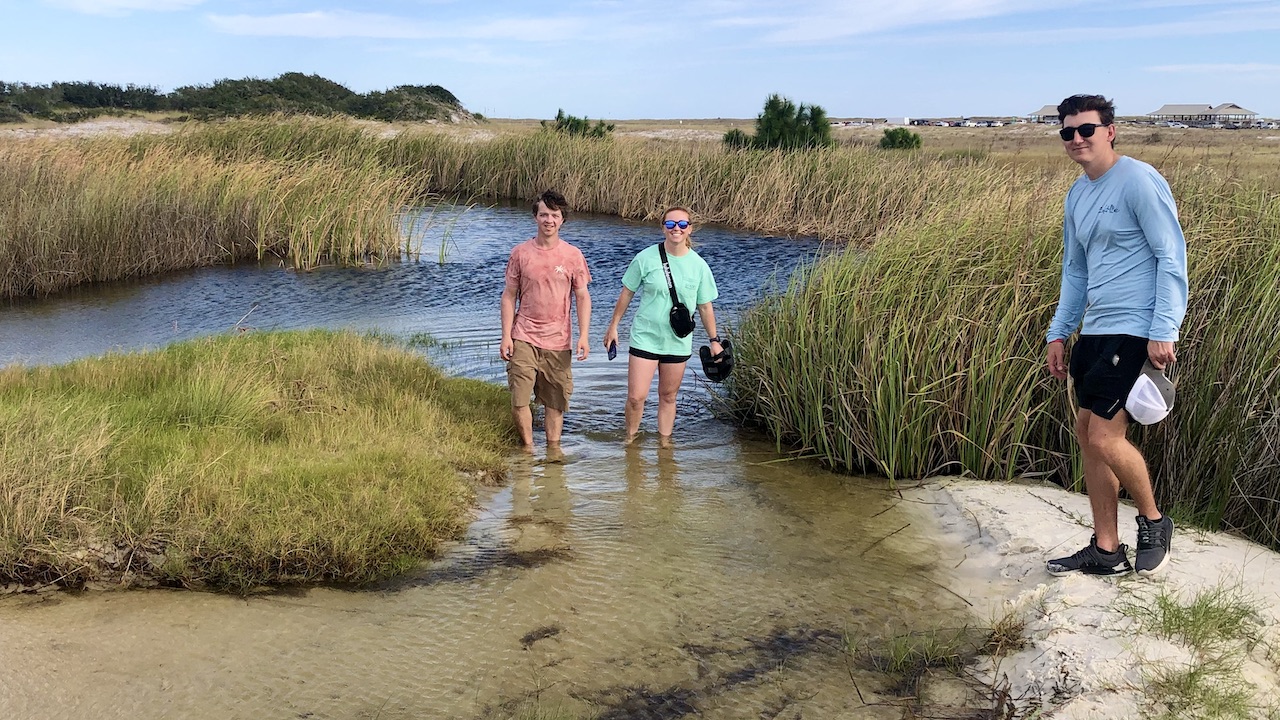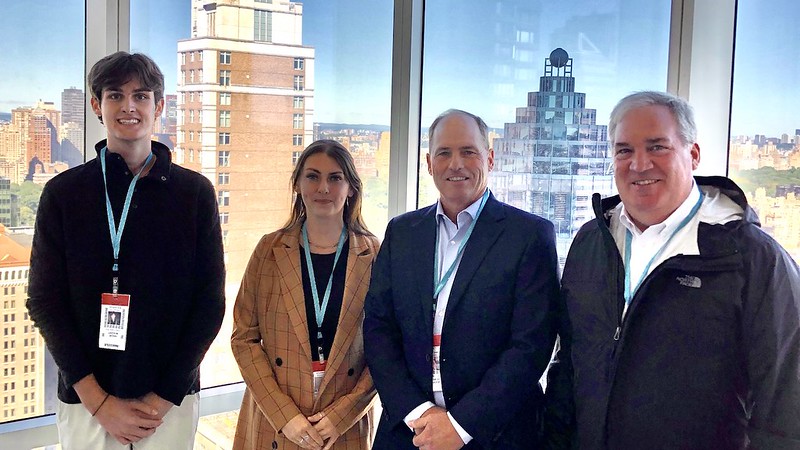content body

CFWE students work in the marsh during Instructor Richard Hall’s Coastal Law class field trip in Navarre, Florida.
Auburn University sophomore Landrum Brown has advice for peers: “If you ever get a chance to study away, I’d highly recommend it,” said the geospatial and environmental informatics major.
“College should not just be about academics, but about expanding your horizons and embracing new experiences.”
Brown had that chance during fall break 2023 when Auburn instructor Richard Hall organized a sustainable finance workshop and urban ecology tour in New York City. There, as one of four on the trip, Brown learned from Bloomberg’s professionals and toured the finance business’ headquarters in Manhattan. The group also visited several high-profile areas of the city.
The trip, not tied to a university course, was one of two study-away activities that Hall, of the College of Forestry, Wildlife and Environment (CFWE), offered to Auburn students that year. He also led a field trip to the beach town of Navarre, Florida, for students in his coastal law class.
The two trips provided students with the kind of experiential learning opportunities that Auburn values — those that allow students to deepen their understanding of concepts learned in the classroom, Hall said.
Through both trips, Hall’s students saw up close places where people have tried to balance development and conservation.

Student Landrum Brown, alumna Kelly Bradford, graduate student Charles Bradford and Instructor Richard Hall (left to right) visited Bloomberg’s headquarters in New York City.
Sustainable finance, urban ecology in the Big Apple
Through the sustainable finance workshop, students learned about investment decisions that consider the environmental, social and governance (ESG) factors of an economic activity or project.
“Understanding how ESG considerations intersect with finance broadened my perspective on the interconnectedness of economic activities and sustainability,” said Brown. “I acquired practical skills in utilizing the Bloomberg terminal to analyze and incorporate sustainable factors into investment strategies.”
The experience exceeded Brown’s expectations: “The professionalism and hospitality Bloomberg extended us made the entire experience really enjoyable.”
Brown also found the urban ecology tour fascinating because it “offered a glimpse into real world environmental initiatives, showcasing tangible efforts and solutions that resonate with [his] aspiration to become an environmental scientist.”
The group visited three public parks and other points of interest. The 160-plus-year-old Central Park; the High Line, a modern park built on a historic freight rail line; and the award-winning Little Island Park in the Hudson River were among them.
Coastal development, conservation on the Gulf
While the sustainable finance workshop and urban ecology tour took students north, those on the coastal law field trip traveled southwest to Navarre, Florida.
Navarre is a fast-growing area along Florida’s Panhandle, near Navarre Beach Marine Park, a U.S. Air Force base and part of the Gulf Islands National Seashore.
About 20 students participated in the field trip, offered twice during the semester. They learned how concepts introduced in the online Coastal Law course apply to real circumstances in Navarre and the surrounding area.
The course, which is part of CFWE’s environmental law and coastal management minors, covers legal and regulatory structures designed to protect people and the environment in coastal zones and delves into related economic and policy considerations.
On the trip, the students gathered concrete insights to use in the course project, which requires them to pick a specific area and then write about related environmental issues and their local impact, Hall said.
Creating a ‘heightened level of awareness’
“It’s about helping students develop the skills to write and focus on a specific issue in a structured way,” Hall said.
“When they look at the condo tower and the swimming pool, they look at it from the standpoint of, ‘How was this zoned? How is this impacting habitat? How are the lights designed?’ All these different things create a heightened level of awareness of how we and our activities interact with the natural environment.”
Interested in experiential learning?
Discover the College of Forestry, Wildlife and Environment’s innovative programmingTommie Cone, who focused her project on salt marsh habitat loss in the northern Gulf of Mexico, said she gained new insights into how people are trying to find the balance of preserving coastal ecosystems surrounded by urban development.
“Navarre Beach is a heavily populated area, so there is a push and pull of humans wanting a vacation spot and still needing the critical habitat salt marshes provide,” she said. “It was an excellent way to learn and see what was being taught in the class with my own eyes.”
Cone, a senior majoring in marine resources management with a minor in coastal management, hopes to apply what she learned through the field trip and other Auburn courses and experiences in an environmental education career.
“I want to be a part of educating people on important topics such as salt marshes, oyster reefs and living shorelines,” she said.
Deepening knowledge — and confidence
Hall said that helping students achieve such future goals is part of what his experiential trips are all about.
“I would hope such experiences give students the confidence as they graduate and move forward to engage in efforts that will help strike a good balance between conservation and development,” Hall said. “And I think they also give students a greater awareness and appreciation for the different types of interactions between nature and people.”




